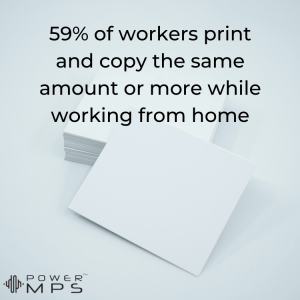The slow move to remote work before 2020 was primarily due to concerns about security. Companies understood that securing virtual workspaces required additional investments in hardware and technology beyond the usual firewalls and processes they could implement directly on their internal servers. And at the time, there was no justification for investing the money in creating the infrastructure to facilitate remote work beyond the occasional salesperson’s laptop.
When the pandemic response of early 2020 took full effect, businesses scrambled to figure out ways to continue operating outside the main office. In many cases, thoughts of security were secondary to ensuring employees could continue working. Once the dust settled, IT began implementing the firewalls and secure point-to-point connections required to regain the standard protections for company information. But, as we continue the slow march out of pandemic response, one major business component is still seen as a security risk – printing.
The Problem With Home Printers
Most businesses (90%) don’t know how many printers they have in their central offices. But the real issue isn’t what machines are sitting at headquarters; the growing problem is the number of home printers used for company printing. When these printers are connected to company computers either directly into a USB or through the same wi-fi network, they pose a potential point of attack to the company’s virtual network.
The first and largest vulnerability is having an unsecured, internet-enabled machine connected to a company computer. Bad actors could hack into the local wi-fi and, using the shared connection, gain access to the printer. The link between the printer and the company computer provides a pathway to bypass any VPN or security. And, once in the employee’s computer, hackers can easily view emails, browse computer files, and even gain access to the business’s primary network.
The second vulnerability is the information stored on the hard drive of even the most inexpensive consumer printer. These hard drives store the images of queued documents for a varying degree of time. As a result, hackers who gain access to an employee’s wi-fi can potentially access any company information included on print jobs sent to that consumer-grade machine.
Why Banning Home Printers Doesn’t Work
The simplest solution to eliminating the risk of company information on personal printers is to lock down what equipment can be linked to the company computer. If the employee can’t directly or remotely connect their home printer, the business network is safe, and company information cannot be transmitted to the printer’s hard drive.
 But employees need to be able to print. During the 2020 shutdown, over half of workers (59%) continued to print and copy the same amount or more while working from home. The drive to print certain documents can push employees to find workarounds even when locked out of using the home printer. One method is to send work documents to private email or cloud accounts. Those documents are then accessed from less secure personal computers and sent to consumer-grade printers.
But employees need to be able to print. During the 2020 shutdown, over half of workers (59%) continued to print and copy the same amount or more while working from home. The drive to print certain documents can push employees to find workarounds even when locked out of using the home printer. One method is to send work documents to private email or cloud accounts. Those documents are then accessed from less secure personal computers and sent to consumer-grade printers.
Employees who work a portion of their time in the main office may have a better option, such as printing remotely to the printers at headquarters. However, if the main printer(s) immediately print everything in their queue, there is the risk of documents being picked up by the wrong employees. In addition, there is the risk of office visitors or other departments accidentally viewing information that does not apply to them or should not have been viewed.
Networked Printers Are A Good Compromise
So, remote and hybrid employees need to print. Companies need to maintain security. Unfortunately, the two requirements seem to be at complete odds. The risks consumer printers pose as an entry point for bad actors is dangerous enough. The possibility of criminals using a back door to view sensitive company information or, worse, gaining access to the company’s internal systems is undoubtedly a daunting prospect. But taking the capacity for safe printing away from employees can affect job performance or lead to other potentially risky behaviors.
The best solution is to select an appropriate compromise in networked printers. Small format office-grade printers such as A3 and A4 models can provide fast and efficient printing for the remote workforce. But, unlike consumer printers, they have additional security functionality which allows for document encryption, port security, and remote monitoring.
Cloud Applications And VPN
In addition to hardware-level measures, these small-footprint networkable machines can use cloud applications or VPN – the same as or similar to what is used to lock down other company hardware. Both options continue the point-to-point protection required to make remote printing a safe option for at-home and hybrid workers. And, just like the business’s laptop and desktop computers, fully supported office-grade networked printers have regular security software updates to counteract new digital attack strategies and detected vulnerabilities.
Employees continue to value printing as an essential aspect of their everyday tasks. Innovative businesses will find ways to facilitate the needs of their people. Small format, office-grade, networked printers can be a viable solution for the discerning company as the configuration and idea of the “traditional” office continues to reshape for the post-COVID future.







